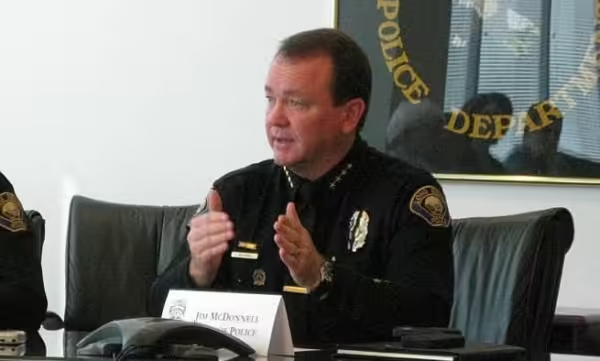If you need help with your ballot, take a look at RLn’s Editorial board’s endorsements for the 2024 General Election. Vote! on Nov. 5.
US President
* Kamala Harris (D), Incumbent Vice President Of The United States.
United States Senator – Full Term
* Adam B. Schiff (United States Representative)
United States Senator – Short Term (Unexpired Term Ending January 3, 2025)
Adam B. Schiff (United States Representative)
United States Representative, 36th District
*Ted W. Lieu (United States Representative)
Us Representative, 42nd District
*Robert Garcia
Us Representative, 44th District
*Nanette Diaz Barragán
State Senator, 33rd District
*Lena A. Gonzalez
Member of The State Senate 35th District
*Michelle Chambers
Member Of The State Assembly, 65th District
*Mike Gipson
Member Of The State Assembly, 66th District
*Al Muratsuchi
Member Of The State Assembly, 69th District
*Josh Lowenthal (Business Owner/Assemblymember)
Los Angeles County District Attorney
* George Gascón (Nonpartisan)
Los Angeles County Judge
Seat #39: * George A. Turner
Seat #48: * Ericka Wiley
Seat #97: * La Shae Henderson
Seat #135: Georgia Huerta
Seat #137: Luz Herrera
Carson City General Municipal Election
Mayor
Lula Davis-Holmes
(Incumbent Mayor)
Jim Dear
(Incumbent Councilmember/Teacher)
Carson City General Municipal Election
District 1
Jawane Hilton
(Incumbent Councilmember/Pastor)
Councilmember District 3
Cedric Hicks Sr.
(Incumbent Councilmember)
Daniel Valdez
(Children Safety Advocate)
Lomita City General Municipal Election
Member Of The City Council, 2nd District
William D. Uphoff
City Of Lomita Councilmember
Ruben D. Lechuga
Software Engineer/Entrepreneur
Wade Kyle
Teacher
Lomita City General Municipal Election
Member Of The City Council, 4th District Vote For 1
Barry M. Waite
Lomita Councilmember
Long Beach City General Municipal Election
Member Of The City Council, 4th District
Herlinda Chico
Trustee, Long Beach City College
Daryl Supernaw
Councilman 4th District
Palos Verdes Estates City General Municipal Election
City Treasurer
Martin J. Petersen
Systems Manager Retired
Palos Verdes Estates City General Municipal Election
Member Of The City Council
Vote For No More Than 2
Derek Lazzaro
Attorney/Planning Commissioner
Desiree “Dez” Myers
Retired IT Manager,
Craig Quinn
Business Executive
State Measure(S)
PROP. 2–AUTHORIZES BONDS FOR PUBLIC SCHOOL AND COMMUNITY
COLLEGE FACILITIES. LEGISLATIVE STATUTE.
Authorizes $10 billion in state general obligation bonds for repairing, upgrading, and constructing facilities at K–12 public schools (including charter schools) and community colleges.
Prop. 3– CONSTITUTIONAL RIGHT TO MARRIAGE. LEGISLATIVE CONSTITUTIONAL AMENDMENT.
Protects marriage equality in the state constitution. Formally repeals Proposition 8, removes the constitutional language indicating that marriage is between a man and a woman, and affirms the fundamental right to marry. Vote Yes.
Prop. 4–AUTHORIZES BONDS FOR SAFE DRINKING WATER, WILDFIRE PREVENTION, AND PROTECTING COMMUNITIES AND NATURAL LANDS FROM CLIMATE RISKS. LEGISLATIVE STATUTE.
Increases funding for critical climate protections and environmental infrastructure projects.
$10 billion in general obligation bonds for water, wildfire prevention, and protection of communities and lands. Vote Yes.
Prop. 5– ALLOWS LOCAL BONDS FOR AFFORDABLE HOUSING AND PUBLIC
INFRASTRUCTURE WITH 55% VOTER APPROVAL. LEGISLATIVE CONSTITUTIONAL AMENDMENT.
Makes it easier to pass local bonds and taxes to fund affordable housing and public infrastructure development. Reduces current 2/3 supermajority requirement to 55%. Still not the majority rule, but a significant improvement. Vote Yes.
Prop.6
ELIMINATES CONSTITUTIONAL PROVISION ALLOWING INVOLUNTARY
SERVITUDE FOR INCARCERATED PERSONS. LEGISLATIVE CONSTITUTIONAL
AMENDMENT.
Eliminates involuntary servitude or slavery of any form as a criminal punishment that the state can use. Allows the Department of Corrections and Rehabilitation to issue credits to incarcerated people for accepting voluntary work assignments during their incarceration. Vote Yes.
Proposition 32
RAISES MINIMUM WAGE. INITIATIVE STATUTE.
Raises the minimum wage to $18 in stages. For employers with 26 or more employees, to $17 immediately, $18 on January 1, 2025. For employers with 25 or fewer employees, to $17 on January 1, 2025, and $18 on January 1, 2026. Vote Yes.
Proposition 33
EXPANDS LOCAL GOVERNMENTS’ AUTHORITY TO ENACT RENT CONTROL ON
RESIDENTIAL PROPERTY. INITIATIVE STATUTE.
Prohibits state limitations on local rent control. Restores local democracy and protects renters. The ability of landlords to drive out tenants through enormous rent hikes is a major contributor to homelessness, so this initiative could also help prevent homelessness. Vote Yes.
Proposition 34
RESTRICTS SPENDING OF PRESCRIPTION DRUG REVENUES BY CERTAIN HEALTH CARE PROVIDERS. INITIATIVE STATUTE.
Initiative financed by many of the largest corporate landlords in the nation to silence housing advocacy work on rent control and other tenant protections currently provided by the AIDS Healthcare Foundation in Los Angeles. Vote No.
Proposition 35
PROVIDES PERMANENT FUNDING FOR MEDI-CAL HEALTH CARE SERVICES.
INITIATIVE STATUTE.
No vote protects investments in critical community health programs, retains higher funding allocations for Medi-Cal, and gives the state legislature more flexibility to respond to community needs. Prop 35 would change the temporary tax that helps fund Medi-Cal to a permanent tax on Managed Care Organizations (MCOs) and require the tax proceeds to be used to support only Medi-Cal and other health programs – making that money unavailable for other priorities and making it difficult to respond to future changes to Medi-Cal. Vote No.
Proposition 36
ALLOWS FELONY CHARGES AND INCREASES SENTENCES FOR CERTAIN DRUG AND THEFT CRIMES. INITIATIVE STATUTE.
The ACLU calls Proposition 36 “a prison spending scam.” It would return us to the over-incarceration practices of the past, and upend the progress that Proposition 47 established to increase community investment in mental health services, substance use treatment, and diversion programs. A fiscal impact statement estimates it will ultimately result in a price tag of hundreds of millions of dollars annually in court costs and the expense of housing an increased prison population. Vote No.
COUNTY OF LOS ANGELES
Majority Vote (50% + 1)
G -PROPOSED COUNTY CHARTER AMENDMENT.
LOS ANGELES COUNTY GOVERNMENT STRUCTURE, ETHICS AND
ACCOUNTABILITY CHARTER AMENDMENT.
Would create a new, elected countywide executive; expand the five-member Board of Supervisors to nine, and would create a purportedly independent ethics commission, in addition to some minor additional transparency measures. Vote Yes.
COUNTY OF LOS ANGELES (1)
Majority Vote (50% + 1)
A- HOMELESSNESS SERVICES AND AFFORDABLE HOUSING ORDINANCE.
Will generate an estimated $1.1 billion in annual revenues to fund affordable housing, services for the unhoused, rental support for tenants, and other much-needed programs. Revenue will come from a new, permanent 0.5% sales tax, which will replace a 0.25% sales tax scheduled to expire in 2027. Expenditures will be strictly allocated according to provisions in the ballot measure, with significant citizen oversight. Vote Yes.
COUNTY OF LOS ANGELES (1)
Majority Vote (50% + 1)
E-CONSOLIDATED FIRE PROTECTION DISTRICT OF LOS ANGELES COUNTY
EMERGENCY RESPONSE AND INFRASTRUCTURE ORDINANCE.
Proposes a parcel tax of $0.06 per square foot to raise an estimated $152 million per year to hire/train firefighters/paramedics, upgrade/replace aging firefighter safety equipment, fire engines, helicopters, facilities, lifesaving rescue tools, and 911 communications technology. Vote Yes.
Los Angeles City- (1)
Vote Passage- Majority Vote (50% + 1)
DD– INDEPENDENT REDISTRICTING COMMISSION FOR THE CITY OF LOS ANGELES.
Establishes an independent redistricting commission to redraw Council district lines every ten years. Vote Yes.
Los Angeles City – (2)
Vote Passage- Majority Vote (50% + 1)
HH–CITY GOVERNANCE, APPOINTMENTS, AND ELECTIONS. CHARTER AMENDMENT
- HH. Does the following:
- Requires that at least one member of the Board of Harbor Commissioners lives in San Pedro and another lives in Wilmington.
- Defines the subpoena and investigative authority of the LA City Attorney.
- Clarifies the LA City Controller’s audit authority over city contractors/subcontractors.
- Requires commission appointees to file financial disclosures that help screen for conflicts of interest before they’re confirmed.
- Provides additional time to evaluate the fiscal impacts of laws proposed by ballot initiatives.
Vote Yes.
Los Angeles City – (3)
Vote Passage- Majority Vote (50% + 1)
II CITY ADMINISTRATION AND OPERATIONS. CHARTER AMENDMENT II.
A collection of City Council-passed charter amendments: to clarify that the El Pueblo Monument and the Zoo are park property; clarify that departments may sell merchandise to support City operations; include gender identity in non-discrimination rules applicable to employment by the City; clarify the Airport Commission’s authority to establish fees and regulations; and make other changes and clarifications. Vote Yes.
Los Angeles City- (4)
Vote Passage- Majority Vote (50% + 1)
ER CITY ETHICS COMMISSION AUTHORITY AND OPERATIONAL INDEPENDENCE. CHARTER AMENDMENT ER.
A minor but worthy improvement to the Ethics Commission, it will increase the ethics code violation penalty from an absurd $5,000 per violation to a paltry $15,000. It will modestly increase the Ethics Commission budget, and create a Charter Reform Commission, but only with an advisory role to the city council. Vote Yes.
Los Angeles City – (5)
Vote Passage- Majority Vote (50% + 1)
FF LOS ANGELES FIRE AND POLICE PENSIONS; PEACE OFFICERS.
CHARTER AMENDMENT FF.
Moves the pensions of non-LAPD city police officers from the LA City Employees’ Retirement System (LACERS) to the Fire & Police Pension Plan at a cost of over $100 million. Vote No.
Los Angeles City and Los Angeles Unified School District (LAUSD) – (1)
Vote Passage- Majority Vote (50% + 1)
LL–INDEPENDENT REDISTRICTING COMMISSION FOR THE LOS ANGELES UNIFIED SCHOOL DISTRICT. CHARTER AMENDMENT LL.
Establishes an independent redistricting commission to redraw LAUSD district lines every ten years. Vote Yes.
Los Angeles Unified School District (LAUSD) – (1)
Vote Passage-55% of the Votes Cast
US Local Public Schools Safety and Upgrades Measure: To update school facilities for 21st-century student learning and career/college preparedness; improve school facilities for safety, earthquakes and disability access; upgrade plumbing, electrical, HVAC; replace leaky roofs; provide learning technology; and create green outdoor classrooms/schoolyards; shall Los Angeles Unified School District’s measure be adopted authorizing $9,000,000,000 in bonds at legal rates, levying approximately 2.5¢ per $100 of assessed valuation (generating $456,123,000 annually) until approximately 2059, with audits/citizens’ oversight? Supporters: Yolie Flores, Families in Schools; Gene Hale, LA AfAm Chamber; Dr. A. McQuarters; Charmaine Morales, RN; Ernesto Medrano, Bldg Trades Opponents: Howard Jarvis, Taxpayers Association; Mike Antonovich, L.A. County Supervisor (ret.); Jack Humphreville.


















